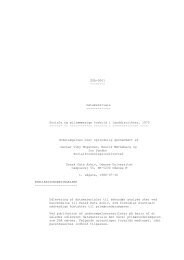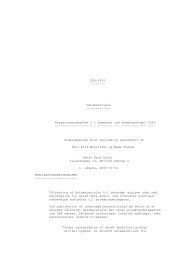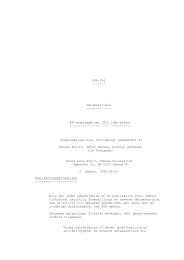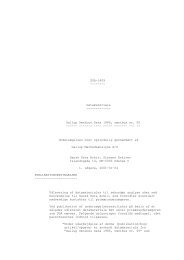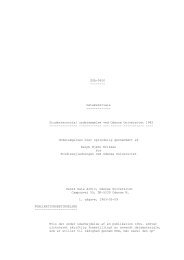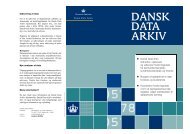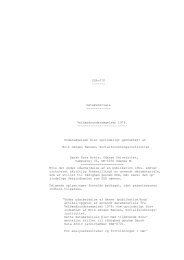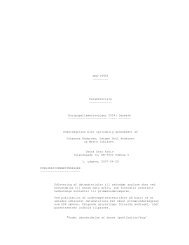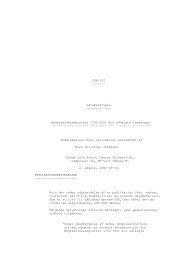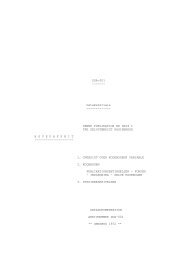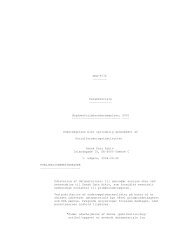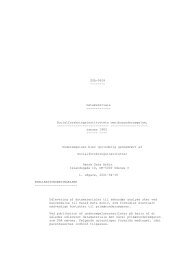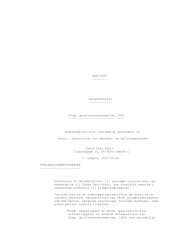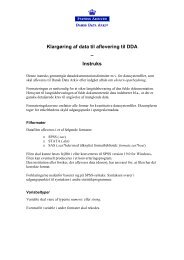Metode og Data nr. 86 - DDA Samfund - Dansk Data Arkiv
Metode og Data nr. 86 - DDA Samfund - Dansk Data Arkiv
Metode og Data nr. 86 - DDA Samfund - Dansk Data Arkiv
You also want an ePaper? Increase the reach of your titles
YUMPU automatically turns print PDFs into web optimized ePapers that Google loves.
<strong>DDA</strong>-4396 „Social Resources and<br />
Course of Disease, 1978“<br />
(Dorte Effersøe Gannik)<br />
The subject of this survey is „disease in<br />
everyday life“, i.e. a description of the<br />
incidence and types of back pain or back<br />
trouble in the population, social correlation,<br />
treatment behaviour and other reactions to the<br />
back trouble. The aim of the questionnaire<br />
survey was to establish the basis for the<br />
selection of a smaller number of persons for<br />
personal in-depth interviews.<br />
The questionnaire survey formed part of a<br />
major project which also consisted of a survey<br />
of course of disease and a description of the<br />
local community. The main purposes of this<br />
survey were:<br />
1. To describe the measures and support of<br />
the primary social and health care services<br />
in connection with the course of a number<br />
of diseases which are particularly suitable<br />
for the purpose (back pain).<br />
2. To compare this description with collected<br />
data on the importance of informal<br />
resources in connection with the same<br />
disease courses in such a way that the<br />
actual correlation between and/or interdependence<br />
of the two structures are<br />
mapped out.<br />
3. If possible on the above-mentioned basis to<br />
assess whether and how the primary social<br />
and health care services by means of<br />
changes regarding organization and<br />
working methods may make the effort<br />
towards the above-mentioned diseases<br />
more effective.<br />
File dimensions: 684 cases, 251 variables.<br />
<strong>DDA</strong>-4604 „Disease Pattern in<br />
General Practice, Aarhus County<br />
1993“<br />
(Svend Juul, Carl Erik Mabeck and Laurits<br />
Ovesen)<br />
The subject of this survey is the disease<br />
pattern in general practice in the County of<br />
Aarhus in 1993, i.e. the purpose is to map out<br />
in detail the disease and contact pattern in<br />
general practice.<br />
In recent years there has been an increased<br />
interest in describing the work of general<br />
practitioners. This interest has, among other<br />
things, manifested itself through increased<br />
research in the field.<br />
The purpose of the information which the<br />
general practitioners registered was to identify<br />
the contact in question in order to obtain as<br />
much information on the patients as possible.<br />
When it was decided to carry out this multipractice<br />
survey in the County of Aarhus in<br />
1993 the main purposes were:<br />
1. To describe the disease pattern of people<br />
who contacted their general practitioner<br />
one day in the period 1 February to 31<br />
December, 1993.<br />
2. To get an idea of why people contact their<br />
general practitioner and which diagnoses<br />
are made, etc.<br />
3. The character of the reasons for contact.<br />
File dimensions: 12237 cases, 37 variables.<br />
<strong>DDA</strong>-6985 „Prevention of Traffic<br />
Accidents, 1993: Follow-Up“<br />
(Kristian Kidholm)<br />
Because of uncertainty of the calculations<br />
of the Danish Road Directorate of loss of<br />
welfare in connection with traffic accidents<br />
and because of the development of improved<br />
methods for the measurement of individual<br />
valuation of traffic safety, a survey was carried<br />
out in February 1993 of the population’s<br />
valuation of traffic safety.<br />
The purpose of the survey is to estimate the<br />
willingness of the population to pay for the<br />
reduction in the risk of fatal and non-fatal<br />
personal injuries in traffic accidents which is<br />
achieved by road works. Thus, the survey<br />
does not examine the population’s valuation<br />
so far of the achieved traffic safety level, but<br />
only the population’s valuation of improvements<br />
of traffic safety.<br />
The data collection took place in<br />
connection with the Danish Omnibus Survey<br />
in February 1993 (<strong>DDA</strong>-1744), and for a<br />
statistical assessment of traffic safety the<br />
following information is obtained:<br />
• whether the respondent has a car and how<br />
much the car is used;<br />
<strong>Metode</strong> & <strong>Data</strong> <strong>nr</strong>. <strong>86</strong> – 2002 side 58




